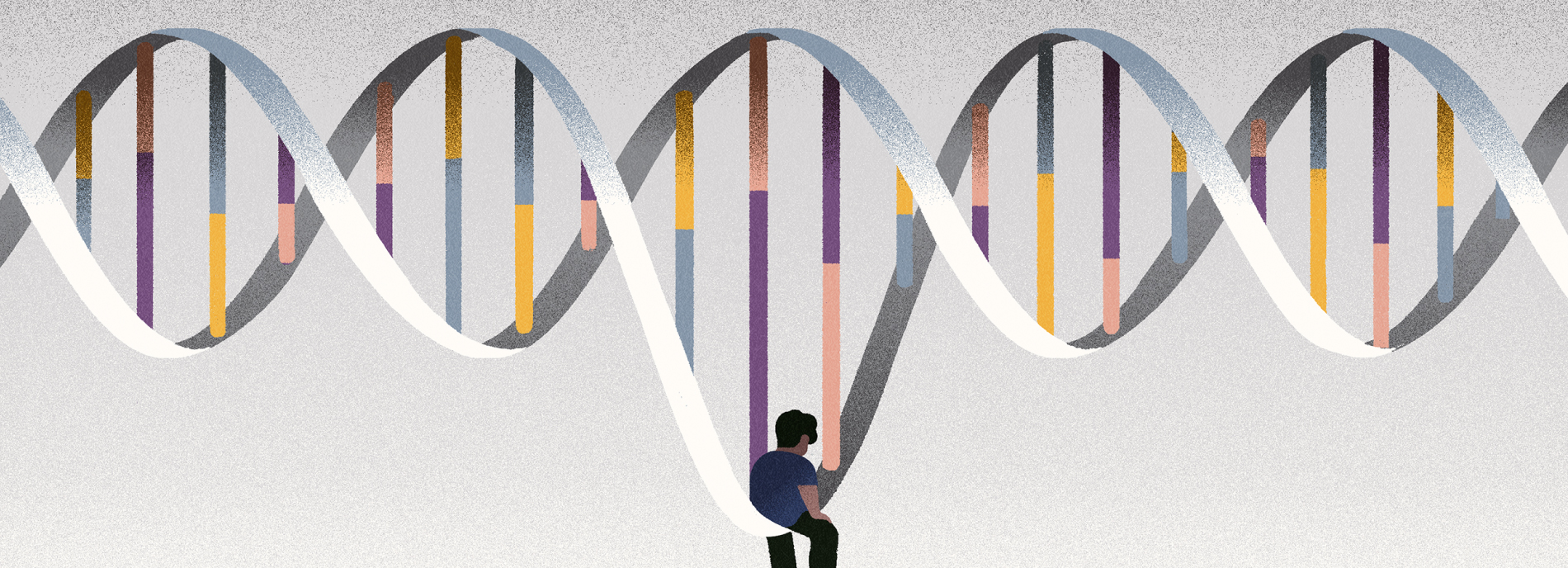
Weighing up autism’s obesity crisis
Autism’s underlying biology, associated behaviors and treatments can all put people on the spectrum at serious risk for obesity.
N
icholas Bavaro has always been bigger than his twin brother. He was nearly a pound heavier than Christopher at birth, and by the time the boys hit their first birthday, their mother, Lynette, had noticed other differences, too. Christopher babbled, made eye contact and pointed as he toddled around the family’s home in Long Island, New York. Nicholas did not — and was soon diagnosed with autism.Obesity runs in the Bavaros’ extended family, but their active lifestyle helps Christopher and the twins’ parents and younger sister keep the extra pounds off. Nicholas, however, doesn’t share their love of sports. He has motor difficulties and is minimally verbal — he often says “no” when the others propose bike rides or long walks.
When Nicholas was little, the fact that he was overweight seemed trivial compared with his communication difficulties and meltdowns, during which he would shout, red-faced, for hours or barricade himself in his room. By the time he was 10, though, his weight had skyrocketed to 170 pounds. At 5 feet 3 inches tall, his body mass index (BMI) was in the highest percentile for boys his age. The pediatrician suggested only that his parents should count his calories. That didn’t work.
Now, at 15, Nicholas is 7 inches taller, nearly 100 pounds heavier and dangerously obese. Much to his parents’ frustration, he is not interested in the health benefits of losing weight, and is oblivious to factors — such as peer acceptance — that can sometimes motivate other children.
Nicholas’ situation is common among young people with autism. A 2014 study of more than 6,000 children and teenagers on the spectrum found that they are more than twice as likely to be overweight and nearly five times as likely to be obese as their typical peers. Those statistics translate to higher rates of a host of associated health issues. A 2016 analysis of Taiwan’s National Health Insurance Research Database revealed that teens with autism are nearly three times more likely to have type 2 diabetes than their typical peers. A 2016 review of medical records from 48,762 children with autism in the United States showed that they also have significantly higher rates of other obesity-related conditions, such as hypertension, high cholesterol and nonalcoholic fatty liver disease.
“We live in an obesogenic environment,” says Carol Curtin, associate professor of family medicine and community health at the University of Massachusetts Eunice Kennedy Shriver Center in Worcester. “It’s still not clear whether these kids are more susceptible to this environment, or if there are unique risk factors; we haven’t been able to do the longitudinal studies that might tell us.”
The research so far hints that obesity in people with autism is different than in the general population. For one thing, weight problems in autism seem to follow a specific course: The pounds start to pile on at a younger age, and persist into adulthood more often. Many people on the spectrum have heightened senses, plus a fondness for routine, which makes them averse to new tastes and textures and susceptible to unhealthy eating patterns. And motor and social impairments, along with an affinity for screens, can limit physical activity.
Unfortunately for children like Nicholas, there is little appreciation of these differences as yet, and weight management programs are almost exclusively geared toward typical children. “If you have special education every day after school, how are you going to fit in sports?” asks Sarabeth Broder-Fingert, a pediatrician at Boston University. “If you have a kid who’s nonverbal, having a conversation about nutrition isn’t going to work.”
Some researchers are adapting programs to help children with autism expand their food choices and be less sedentary. The data trickling in suggest that these nascent programs offer benefits beyond physical health: In some young people with autism, they can also boost social functioning and self-esteem.

A growing problem:
S
erious concerns about childhood obesity first surfaced following a 2002 report from the U.S. National Center for Health Statistics. Within a few years, that same worry reached clinicians treating children with autism.In 2005, Curtin and her colleagues conducted a chart review of 140 children and teens who had visited the special-needs clinic at Tufts Medical Center in Boston. They hoped to get a sense of obesity’s prevalence in this group. The records they pulled included information from 42 children with autism, ages 3 to 18, almost a fifth of whom were overweight. That fraction, they found, rose to half among teens on the spectrum. And more than a third of the children with autism had a BMI above the 85th percentile, placing them at risk for becoming overweight.
Larger studies later confirmed the pattern. In a 2015 study, researchers reported that weight issues begin early among children on the spectrum: 16 percent are overweight and another 16 percent are obese between ages 2 and 5. A study last year revealed that unlike many typical children, who outgrow weight problems as teenagers, those with autism usually do not. These results came as no surprise to Curtin, who had been trying to raise awareness about obesity in autism since her 2005 analysis. When Curtin had applied for funding to get more data, though, she had been roundly rejected. “No one believed it was an issue,” she says. “In autism, the focus is mostly on behavior; physical health is largely ignored.”
Compared with behavioral issues such as aggression, the physical consequences of autism or its treatment may seem less urgent — and yet nearly all increase the risk for obesity. The vast majority of children with autism have sleep issues or gastrointestinal problems, both of which can contribute to weight issues. Many take drugs for epilepsy, anxiety or depression that can also cause them to pack on pounds. And weight gain is a common side effect of antipsychotics such as risperidone and aripiprazole, the only medications approved by the U.S. Food and Drug Administration for treating issues related to autism.
In addition, some children with autism have a genetic susceptibility to obesity. “In kids like this, it could be differences in hormones and biochemistry that contribute to obesity, rather than too much screen time,” says Broder-Fingert.
In 2010, two groups of scientists found that individuals with a deletion of 25 genes on chromosome 16 are much more likely to have autism, developmental delay and obesity than controls are. The deletion, known as 16p11.2, affects only 0.5 percent of people with autism, but nearly 3 percent of individuals with this deletion are also obese. More evidence that these genes play a role in body weight came the following year. Some of the same scientists found that the opposite scenario — a duplication along this region of chromosome 16 — increases the risk of extreme thinness. Children with the duplication often have autism and intellectual disability, plus a low birth weight. In contrast to children with the deletion, who tend to be hungry all the time, those with the duplication may be easily sated and have trouble gaining weight.
A large deletion on chromosome 11, associated with autism and attention deficit hyperactivity disorder, falls within a stretch of genes linked to intellectual disability and obesity. And a large deletion on chromosome 15 leads to Prader-Willi syndrome; this syndrome is characterized by intellectual disability and, in some cases, autism. As early as toddlerhood, children with the syndrome are prone to severe overeating, which leads to extreme obesity from an early age.
These rare chromosomal deletions linked to autism all appear to affect the body’s drive to eat and ability to sense when it’s full. But the innate regulation of appetite and eating may also be altered in children with autism who don’t have one of these deletions, says Paula Krakowiak, a research scientist at the University of California, Davis. Krakowiak notes that studies have associated autism with inflammation, which can interfere with metabolism, the body’s ability to balance food eaten with energy burned. “Immune dysregulation can create a positive feedback loop of inflammation, weight gain, then more inflammation and so on,” she says. “These two systems interact and overlap.”
Inflammatory conditions such as diabetes, hypertension, celiac disease and rheumatoid arthritis are also more common in women who have children with autism. In a 2016 study, Krakowiak and her colleagues found that women with gestational diabetes sometimes produce anti-fetal antibodies — molecules thought to attack the fetal brain and increase the child’s autism risk. These antibodies were especially prevalent in women with children at the severe end of the spectrum. Obesity in the mother produces high levels of certain immune molecules, which in turn may lead to the production of these antibodies.
Because obesity is heritable, the parents’ tendency to gain weight could be passed along to their children. “A large proportion of these children may just be unusually predisposed to gaining weight easily,” Krakowiak says.
”“A large proportion of these children may just be unusually predisposed to gaining weight easily.” Paula Krakowiak
Weighing the risks:
S
ome scientists work to identify biological connections between autism and obesity, whereas others, including Curtin, have been developing strategies to treat weight gain in young people on the spectrum. When the U.S. Maternal and Child Health Bureau put out a call for research on obesity in children with developmental disabilities about five years ago, Curtin was one of the first scientists to apply. In 2013, she and her colleagues received a three-year grant to start the Healthy Weight Research Network. In 2017, the bureau renewed the group’s funding for another five years. The network has about a dozen core researchers who are conducting secondary analyses on existing datasets. It also funds pilot projects and helps members apply for external funding to investigate obesity risk factors and treatments in special-needs children.One major research question is how autism amplifies common risks for obesity. Take diet, says Brooke Sweeney, medical director of Children’s Mercy-Kansas City’s Weight Management Clinic: Most children gravitate toward high-carbohydrate, high-fat, high-calorie items such as chicken nuggets and French fries — staples on nearly every U.S. restaurant’s children’s menu. Typical children tend to diversify their diet over time, eventually even learning to like broccoli, spinach and other vegetables. But children with autism find it more challenging to branch out from high-calorie diets and known favorites, Sweeney says. (Different flavors of picky eating can contribute to other eating disorders in children on the spectrum.)
They also tend to be less active than their peers. A 2016 survey found that adolescents with autism are 60 percent less likely to be physically active three or more days a week, and 74 percent less likely to have played a sport in the previous year, than their peers. There are several reasons for this: Typical children may not invite children with autism to join games or sports teams, and the latter may avoid team sports because they don’t know how to engage with the other players or they worry about not understanding the rules. “In physical education classes at school, it’s a team sport environment every day,” says Kristi Menear, a researcher focused on physical and special education at the University of Alabama at Birmingham. “But children with autism have difficulties with activities without lots of repetition, and that have a changing social context.”
Motor problems only add to those social challenges. A long line of research has shown that individuals on the spectrum struggle with gross motor skills such as running, balance, flexibility and hand-eye coordination — key skills in any sport. Carrie Cariello recalls that it took her son Jack, who has autism, longer than his four siblings to learn to ride a bike, and he tended to fall off more readily, which provoked much anxiety in him. “Three years ago, Jack had a spill on the driveway — just a few scrapes. But it took him more than a year to start riding again,” Cariello says. As a result, Jack, now 13 — who Cariello says would eat chicken fingers every night if she let him — spends more of his time on solitary, sedentary pursuits.
To prevent weight issues in children with autism before they start, Curtin and other researchers recommend early screening for genetic conditions that can contribute to obesity. They also stress the importance of teaching parents about healthy routines. In 2013, Curtin launched the ‘Health U.’ curriculum to guide clinicians seeing teens with intellectual and developmental disabilities. The lessons review nutrition and exercise, encouraging the teens to participate in fitness classes, taste-test different fruits and vegetables and play interactive games that help them work physical activity into household chores or even into watching television. “We try to make it interesting and fun, and they often try things they might not have done before,” Curtin says.
However fun it might be, this sort of education doesn’t work for all families — and is not always enough. Some researchers, including Broder-Fingert, are adapting pediatric obesity treatments for young people on the spectrum. Compared with programs for typical children, these initiatives take a slower approach to weight loss, one that gives the children more choices. “There isn’t a need to reinvent the wheel; we just needed to make some small but important changes,” Broder-Fingert says.
For instance, clinicians might advise the parents of a typical child to throw away all the sugary drinks in the house and replace them with water, with the idea that the child might balk and whine at first, but will give in to thirst. A child with autism, however, might not switch so easily. Curtin instead recommends swapping out one soda for one seltzer water a day, gradually working toward a total substitution.
”“It’s still not clear whether these kids are more susceptible to this [obesogenic] environment, or if there are unique risk factors.” Carol Curtin
Healthy choice:
A
t her clinic at the Medical University of South Carolina, psychiatrist Eve Spratt was used to seeing families who had tried everything and given up. These families were told things such as “eat more fruits and vegetables,” Spratt says, but that was impossible when their children might eat only four foods and wouldn’t touch anything green. The parents were often told to take away the child’s iPad and send her outside to play — neither of which was really an option if losing screen time might provoke an hours-long meltdown or might cause the child to wander off, get lost or hurt herself. The parents who came to Spratt knew they needed to address their child’s physical health issues, but had not found anything that worked.In 2014, Spratt started co-directing a six-week day camp for teens and young adults with autism or other conditions — a program that has since expanded to offer after-school classes. To increase food variety, Spratt and her colleagues introduce participants to the university garden, showing them how the vegetables are grown, what nutrients they have and what they look like when they are freshly picked. This approach piques the teens’ interest in trying the vegetables, she says. The program also includes stress management techniques, such as yoga and deep breathing, and physical activity. Due to their heightened senses, many young people with autism don’t like to sweat, nor do they like the pounding pulse that accompanies physical exertion or the loud music in many exercise classes. So when they work out, Spratt turns on fans, lowers the volume on the music and helps them learn how to tolerate their discomfort. “I ask them to be brave enough to get a little bit out of their comfort zone,” she says.
Over the past three years, few of the participants have lost a significant amount of weight, but most of them have stopped gaining and have put on muscle. Most participants from the 2015 camp report that they now eat more fruits and vegetables. They also became less depressed. Spratt and her colleagues presented the findings at the 2016 meeting of the American Academy of Child and Adolescent Psychiatry.

Numerous small studies show that for children on the spectrum, regular physical activity can boost mood and self-worth, and also improve social skills and self-control. These transformations are the most rewarding to witness, Spratt says. “Many of these kids didn’t think they could do sports, so when they actually start participating, they feel so much better about who they are,” she says. Spratt recalls one girl who rarely spoke to her fellow campers at the beginning of the program but, after participating for two years, is now among its leaders.
Lynette Bavaro tried several exercise programs with her son Nicholas to try to make him more active, until she found one that stuck. The program’s founder drew on his training in applied behavioral analysis, the most widely used therapy for autism, to devise a routine for Nicholas. The routine relies on medicine balls, calisthenics and small hurdles to hone Nicholas’ motor skills and boost his metabolism.
Nicholas has been in the program for several years. He hasn’t lost weight, but he has stopped gaining. He also has more endurance when he joins his family on hikes and bike rides — although he still often passes on these outings. “He doesn’t need to love sports,” his mother says, “but seeing him be active almost every day helps me know he’ll be healthier even after I’m gone.” She says Nicholas grins and nods whenever he sets out to do his routine. It’s an important step in the right direction.
Syndication
This article was republished in The Atlantic.
Recommended reading

New organoid atlas unveils four neurodevelopmental signatures

Glutamate receptors, mRNA transcripts and SYNGAP1; and more

Among brain changes studied in autism, spotlight shifts to subcortex
Explore more from The Transmitter

Psychedelics research in rodents has a behavior problem
Can neuroscientists decode memories solely from a map of synaptic connections?
